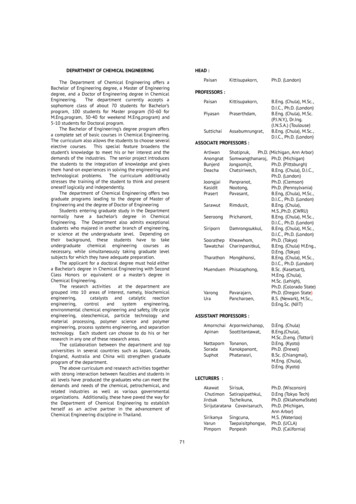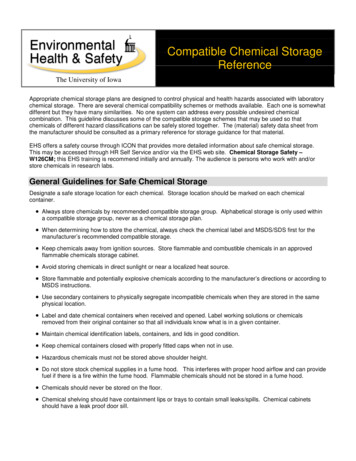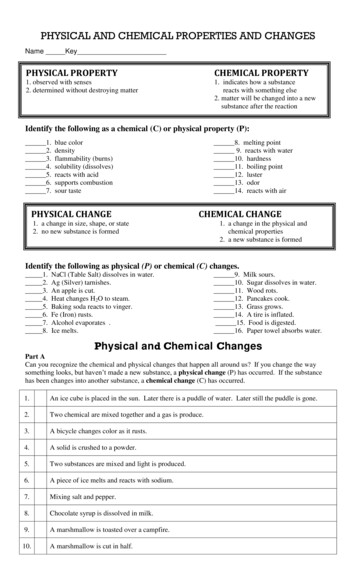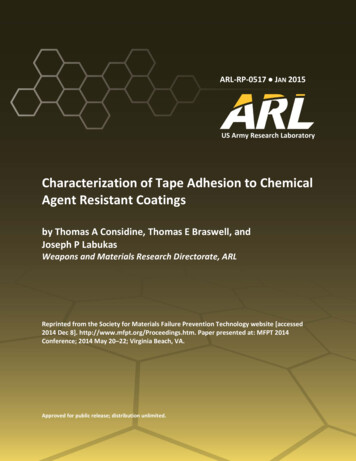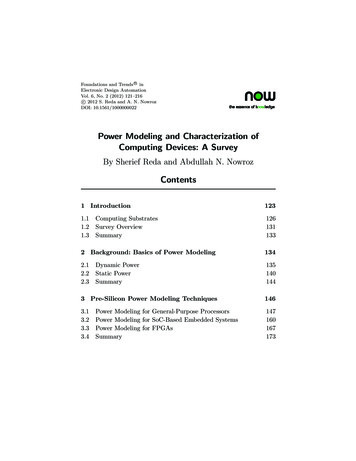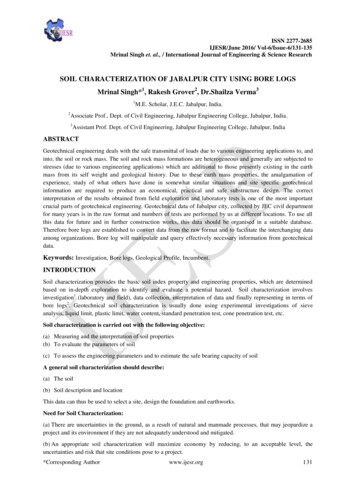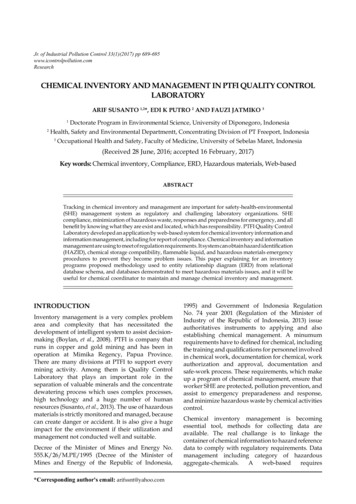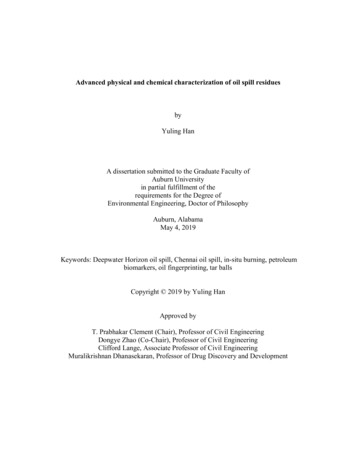
Transcription
Advanced physical and chemical characterization of oil spill residuesbyYuling HanA dissertation submitted to the Graduate Faculty ofAuburn Universityin partial fulfillment of therequirements for the Degree ofEnvironmental Engineering, Doctor of PhilosophyAuburn, AlabamaMay 4, 2019Keywords: Deepwater Horizon oil spill, Chennai oil spill, in-situ burning, petroleumbiomarkers, oil fingerprinting, tar ballsCopyright 2019 by Yuling HanApproved byT. Prabhakar Clement (Chair), Professor of Civil EngineeringDongye Zhao (Co-Chair), Professor of Civil EngineeringClifford Lange, Associate Professor of Civil EngineeringMuralikrishnan Dhanasekaran, Professor of Drug Discovery and Development
AbstractOil spill contamination is a worldwide problem. On April 20th, 2010, the DeepwaterHorizon (DWH) oil platform located off the coast of Louisiana exploded and sank after 2 days.The wellhead could not be sealed until July 15th, 2010, and this resulted releasing about 4.9million barrels (650,000 metric tons) of crude oil into the Gulf of Mexico (GOM). It wasreported that the DWH oil spill contaminated over 1,700 kilometers of GOM shoreline andimpacted several amenity beaches, marshes and other ecologically sensitive coastal ecosystemsalong Texas, Louisiana, Mississippi, Alabama and Florida. More recently, on January 28th,2017, another relatively smaller oil spill occurred when two cargo ships collided about two milesaway from the Ennore Kamarajar shipping terminal near Chennai City, India, resulting in amajor oil spill known as the Chennai oil spill. This accident released about 75 metric tons of theheavy bunker oil into the Bay of Bengal and contaminated 25 miles of the coastline extendingfrom Chennai’s northern suburban town Ennore all the way to the southern suburban townThiruvanmiyur. In this study, source identification and advanced characterization methods werecompleted to investigate the residues from these two oil spills.In the first part of the study, a simple 2-tier field testing protocol, which is based onunique physical characteristics of the oil spill residues, is developed for identifying DWH oilspill residues. A variety of oil samples originated from different oil spill events were testedusing the protocol and the samples were classified into “DWH samples” and “non-DWHsamples”. The results were verified by analyzing the samples with advanced chemicalfingerprinting methods. The verification results matched the results derived from the fieldtesting protocol. The proposed protocol is a reliable and cost-effective field testing approach fordifferentiating DWH oil spill residues from other types of petroleum residues.ii
The second part of the study is to understand the impacts of burning and excessiveheating on hopane biomarkers which are typically used for fingerprinting oil spill residues. Inthe study, laboratory-scale in situ burning (ISB) experiments were conducted using two types ofoils: a model oil prepared using C30-αβ hopane standard, and a DWH reference crude collectedfrom the MC252 well. Our experimental data show that C30-αβ hopane will decrease followingan ISB event, although the diagnostic ratios of hopanes will remain stable. Therefore, whilerelative concentration of different types of hopanes can be used for fingerprinting, C30-αβ hopanecannot be used as a conservative biomarker.In the third part, thermal degradation patterns of hopane biomarkers at high temperatureswere investigated by heating the oil samples in an oven. Our data show that C30-αβ hopane incrude oil starts to degrade at about 160 C, which is lower than the temperature an oil slick willencounter during a typical ISB event. We also found the degradation level of C30-αβ hopaneincreases with the increase of heating temperature and heating time. The diagnostic ratios ofhopanes also changed when the oil was heated at higher temperatures for longer times. Overall,heating is an important process that can degrade hopane biomarkers and it can also change theirrelative ratios and hence the fingerprint.In the fourth part, we completed a case study of 2017 Chennai oil spill based on bothfield-scale observational data and chemical characterization data. Our field survey shows thatafter the spill large amounts of oil was trapped within a relatively stagnant zones near theseawall-groin intersection regions, and this trapping pattern was unique to the Chennai oil spill.The initial cleanup efforts that used manual methods to skim the floating oil and scrub the oilcontaminated rocks were relatively effective. The chemical characterization data studied theunique hopanes and steranes fingerprints for the source oil, which can be used for identificationiii
and tracking of the oil spill residues. Our experimental studies also show that evaporation is asignificant weathering process. During initial hours, the volatile compounds depleted ratherrapidly, resulting in the accumulation of heavy polycyclic aromatic hydrocarbons (PAHs) in thecrude. Most of these highly toxic heavy PAHs are recalcitrant, and their long-termenvironmental impacts are largely unknown.In the final section, we summarize the key findings of this study and also point out somerecommendations for future research.iv
AcknowledgmentsI would like to express my sincere acknowledgments to my advisor, Dr. T. PrabhakarClement, for his patient guidance, mentorship and support during my study at AuburnUniversity. Without his guidance and persistent help this dissertation would not have beenpossible. I would also like to thank my committee members, Dr. Dongye Zhao, Dr. CliffordLange and Dr. Muralikrishnan Dhanasekaran, and my dissertation reader Dr. Ramesh B.Jeganathan for their valuable comments and suggestions regarding my dissertation.Special thanks to my group colleagues, Dr. Fang Yin and Dr. Gerald John for their help inproject design, experimental preparation and instrumental exploration. My other colleaguesSarah Gustitus, Sama S. Memari and Qing Chang helped with sample collection. I value theirfriendship and support.Finally, my great gratitude goes to my husband, Nan Shi, for his enduring love and selflessdedication. I want to express my profound appreciation to my parents and older sister. Theirunfailing love and constant encouragement always guide and inspire me. Thanks to the City ofOrange Beach, Alabama, USA, the National Science Foundation (NSF) and Samuel GinnCollege of Engineering, Auburn University, and the Center for Water Quality Research at theUniversity of Alabama for funding this research. Thanks to China Scholarship Council (CSC)for the financial support.v
Table of contentsAbstractiiAcknowledgments. vTable of contents . viList of Tables . xList of Figures . xiList of Abbreviations . xv1Chapter 1. 11Introduction . 11.1Background . 11.2Fate of spilled oil . 21.2.1Factors that affect the initial fate of spilled oil . 21.2.2Understanding the overall oil spill budget (case for the DWH oil spill) . 41.3Petroleum biomarkers and their role in oil spill investigations . 51.3.1Bicyclic sesquiterpanes. 61.3.2Diamondoids . 71.3.3Biomarker terpanes (hopanes) . 71.3.4Steranes . 81.4Application of petroleum biomarkers . 91.4.1Source identification and differentiation . 91.4.2Oil type differentiation . 101.4.3Quantifying toxic chemicals and their weathering levels . 101.5The utilization of biomarkers in DWH oil spill studies . 11vi
Objectives of this study . 121.62Chapter 2. 132Development of a field testing protocol for identifying Deepwater Horizon oil spillresidues trapped near Gulf of Mexico beaches . 132.1Introduction . 132.2Materials and methods . 162.2.1Details of the field samples . 162.2.2Details of the proposed protocol . 182.3Results and discussion. 262.3.1Tier-1 test results . 262.3.2Tier-2 tests results . 282.3.3Verification of the proposed field test results using Tier-3 chemicalcharacterization datasets . 292.4Summary and conclusions. 373Chapter 3. 393Fate of hopane biomarkers during in-situ burning of crude oil – A laboratory-scalestudy393.1Introduction . 393.2Experimental methods . 423.2.1Materials . 423.2.2Experimental design . 423.2.3Column fractionation and GC/MS analysis . 453.2.4Quantification of hopane degradation . 463.3Results and discussion. 46vii
3.4Conclusion. 524Chapter 4. 544Understanding the thermal degradation patterns of hopane biomarker compoundspresent in crude oil . 544.1Introduction . 544.2Experimental methods . 574.2.1Materials . 574.2.2Desgin of thermal degradation experiment . 574.2.3Samples cleanup procedure . 594.2.4GC/MS analysis . 604.2.5Quantification of hopane degradation . 604.2.6Analysis of kinetics data . 614.3Results and discussion. 614.3.1Thermal degradation of C30-αβ hopane in the model oil . 614.3.2Thermal degradation of C30-αβ hopane in MC252 crude oil . 634.3.3Thermal degradation patterns of other hopanes present in MC252 crude oil . 654.3.4Stability of hopane diagnostic ratios . 684.4Conclusion. 715Chapter 5. 725Environmental impacts of the Chennai oil spill accident – A case study. 725.1Introduction . 725.2Field observations and sampling methods . 755.3Materials and methods . 795.3.1Laboratory materials . 79viii
5.3.2Samples preparation and cleanup methods . 805.3.3Details of GC-FID and GC/MS methods . 815.4Results and discussion. 835.4.1Physical characteristics of Chennai oil spill residues . 835.4.2Biomarker data for Chennai oil spill . 835.4.3Understanding the volatilization patterns of Chennai oil spill . 875.4.4Characterization of total petroleum compounds and n-alkanes in Chennai oilspill samples905.4.5Chemical characterization of PAHs in Chennai oil spill samples . 955.5Conclusion and discussion . 976Chapter 6. 1016Conclusions and recommendations . 10176.1Conclusions . 1016.2Recommendations . 103References . 105ix
List of TablesTable 2.1 Details of DWH oil spill residues collected during a field survey completed on Nov.11, 2015. . 18Table 2.2 Summary of Tier-1 screening test results for all the field samples. . 28Table 2.3 Summary of the results of Tier-2 tests. . 29Table 2.4 The diagnostic ratios (DRs) of hopanes for all the field samples. . 31Table 2.5 Concentrations of PAHs measured in all the field samples. . 35Table 4.1 The percentage of different types of hopanes remaining in MC252 oil after heating it atdifferent temperatures for 10 minutes (%). (-- indicates less than 1%). . 66Table 4.2 The percentage of different types of hopanes remaining in MC252 oil after heating itfor various amount of time at a fixed temperature of 200 C (%). (-- indicates lessthan 1%). . 68Table 5.1 The comparison of hopane diagnostic ratios of oil samples from three different oilspills. . 85Table 5.2 Parent PAHs concentration measured in source oil and indoor and outdoor-weatheredoil (mg/kg of oil). Concentrations are normalized to initial oil weight. . 89Table 5.3 Distribution of various types of GC-FID detectable petroleum hydrocarbons inChennai oil spill samples. . 92Table 5.4 Concentration of n-alkanes in Chennai oil spill samples (mg/kg-oil). . 93Table 5.5 Concentration of parent PAHs and alkylated PAHs present in Chennai oil spill samples(mg/kg-oil). . 96x
List of FiguresFigure 1.1 Molecular structures of hopanes and steranes . . 9Figure 2.1 Oil spill residues collected from five different Alabama beaches on November 11th2015 in the left side picture and residues collected from Fort Morgan (218 samplesof total weight 836 grams; sampling distance 1 km, and sampling time 1 hour) inthe right side picture. . 18Figure 2.2 Details of proposed field testing protocol for identifying DWH oil spill residues. . 19Figure 2.3 Tier-1 test results for the field samples. . 27Figure 2.4 Radar plots of hopane diagnostic ratios of the field samples. . 32Figure 2.5 Mountain plots of sterane chromatograms (m/z 217) for all eleven samples. Data forDWH residues are on the right and non-DWH samples are in the left. [Peak 1:DiaC27βα(S), 2: DiaC27βα(R), 3: C27ααα(S), 4: αββ(R), 5: C27αββ(S), 6:C27ααα(R), 7: C28ααα(S), 8: C28αββ(R), 9: C28αββ(S), 10: C28ααα(R), 11:C29ααα(S), 12: C29αββ(R), 13: C29αββ(S), 14: C29ααα(R)]. 34Figure 2.6 Comparison of PAH concentration levels of five important groups of PAHs and theiralkylated homologs in the field samples. [1: C0-naphthalene, 2: C1-naphthalenes, 3:C2-naphthalenes, 4: C3-naphthalenes, 5: C4-naphthalenes, 6: C0-fluorene, 7: C1fluorenes, 8: C2-fluorenes, 9: C3-fluorenes, 10: C0-phenanthrene, 11: C1phenanthrenes, 12: C2-phenanthrenes, 13: C3-phenanthrenes, 14: C4-phenanthrenes,15: C0-dibenzothiophene, 16: C1-dibenzothiophenes, 17: C2-dibenzothiophenes, 18:xi
C3-dibenzothiophenes, 19: C0-chrysene, 20: C1-chrysenes, 21: C2-chrysenes, 22: C3chrysenes, 23: C4-chrysenes]. . 37Figure 3.1 Comparison of C30-αβ hopane remaining in pre-burn and post-burn solutions ofmodel and crude oils after 1,2,4,8 and 16 burns. . 47Figure 3.2 Extracted ion chromatogram of terpanes (m/z of 191) in pre-burn solutions of modeland crude oils. . 48Figure 3.3 Different types of hopanes (that are typically used for developing diagnostic ratios)remaining in post-burn residues of MC252 crude oil after 1,2,4,8 and 16 burns. . 49Figure 3.4 Comparison of characteristic hopane diagnostic ratios in post-burn residues of MC252crude oil after 1,2,4,8 and 16 burns with that of pre-burn MC252 oil (control). 51Figure 3.5 (a) Comparison of hopanes remaining in the oil-on-water burning experiment. Thefloating oil was consecutively burnt 16 times over water and hopane levels werenormalized to the levels in the unburnt control sample. (b) Comparison of hopanediagnostic ratios of unburnt control and burnt residues. 52Figure 4.1 Thermal degradation levels of C30-αβ hopane in the model oil at differenttemperatures after 10 minutes of heating. 62Figure 4.2 C30-αβ hopane thermal degradation kinetic data for the model oil collected atdifferent temperatures. The dotted lines are fitted first-order kinetic model results. 63Figure 4.3 Thermal degradation levels of C30-αβ hopane in MC252 source crude oil at differenttemperatures after 10 minutes of heating. 64xii
Figure 4.4 C30-αβ hopane thermal degradation kinetics data for MC252 source crude oil collectedat different temperatures. The dotted lines are fitted first-order kinetic model results. 65Figure 4.5 Thermal degradation patterns of different types of hopanes present in MC252 crudeoil. The samples were heated at different fixed temperatures for 10 minutes. . 66Figure 4.6 Thermal degradation kinetics of different types of hopanes in MC252 crude oil. Thesamples were heated for various amount of time at a fixed temperature of 200 C. . 67Figure 4.7 Comparison of characteristic hopane diagnostic ratios in MC252 crude oil residuesafter heating the oil at different temperatures for 10 minutes. . 69Figure 4.8 Comparison of characteristic hopane diagnostic ratios in MC252 crude oil residuesafter heating the oil for various amount of time at a fixed temperature of 200 C. 71Figure 5.1 2017 Chennai oil spill location. . 73Figure 5.2 (a) The groins installed along North Chennai beaches; (b) a close-up view of a groin. 76Figure 5.3 (a) Oil remain trapped near a groin-seawall boundary close to Bharathiyar beach aweek after the spill; the figure also shows a human chain of workers manuallyremoving the oil; (b) cleanup workers scoping the floating oil; (c) recovered oiltemporarily stored in buckets; (d) workers transporting the oil and transferring it intoplastic containers. . 77Figure 5.4 Contaminated rocks in Bharathiyar beach cleaned manually by scrubbing rocks andalso by using a high pressure washer. The inset shows a close-up view of an oiltainted rock sample (pictures taken on March 23rd 2017). . 78xiii
Figure 5.5 Extracted ion chromatogram of hopanes (m/z of 191) present in Chennai oil spillsamples (data normalized to internal standard response). . 84Figure 5.6 Radar plot of hopane diagnostic ratios of 3 Chennai oil samples. . 85Figure 5.7 Extracted ion chromatograms of steranes (m/z of 217) for 3 Chennai oil samples.[Peak 1: DiaC27βα(S); Peak 2: DiaC27βα(R); Peak 3: C27ααα(S); Peak 4: C27αββ(R);Peak 5: C27αββ(S); Peak 6: C27ααα(R); Peak 7: C28ααα(S); Peak 8: C28αββ(R); Peak9: C28αββ(S); Peak 10: C28ααα(R); Peak 11: C29ααα(S); Peak 12: C29αββ(R); Peak13: C29αββ(S); Peak 14: C29ααα(R)]. 86Figure 5.8 volatilization patterns of Chennai source oil under indoor and outdoor conditions. 89Figure 5.9 GC-FID chromatograms of petroleum hydrocarbons present in Chennai oil spillsamples. . 91Figure 5.10 Extracted ion chromatograms of n-alkanes (m/z of 85) present in Chennai oil spillsamples. . 93xiv
List of AbbreviationsDWHDeepwater HorizonBPBritish PetroleumGOMGulf of MexicoMC252Macondo Prospect 252GBGalveston BayISBIn-situ burningPAHsPolycyclic aromatic hydrocarbonsTPHTotal petroleum hydrocarbonsTSHTotal saturated hydrocarbonsTAHTotal aromatic hydrocarbonsUCMUnresolved complex mixtureGC/MSGas Chromatograph/Single Quadrupole Mass SpectrometerGC/MS/MSGas Chromatograph/Triple Quadrupole Mass SpectrometerGC/FIDGas Chromatograph/Flame ionization detectorSIMSelected ion monitoringMRMMultiple reaction monitoringQqQTriple quadrupoleCECollision energyCIDCollision induced dissociationTSTime segmentSOMsSediment-oil matsSRBsSurface residual oil ballsxv
SOAsSediment-oil agglomeratesOSATOperational science advisory teamNRCNational research councilNISTNational Institutes of Standards and TechnologyUSEPAUnited States Environmental Protection AgencyISInternal standardSSSurrogate standardsEIElectron ionizationDRsDiagnostic ratiosRRFRelative response factorLODLimit of detectionLOQLimit of quantitationDLBelow detection limitxvi
111.1Chapter 1IntroductionBackgroundOn April 20th, 2010, a semi-submersible drilling rig located 50 miles off Louisianashoreline experienced well blow-out and exploded. Until July 15th, 2010 when the wellhead wassealed, approximately 4.9 million barrels of crude oil was released from the Macondo well(MC252) at a depth of 1500 m, resulting in one of the largest marine oil spill disasters in the UShistory (McNutt et al., 2012). Alabama is around 120 miles distance from the spill location.After about one month of DWH oil spill, in early June 2010, the oil started washing ontoAlabama shoreline (J. S. Hayworth, Clement, & Valentine, 2011; Nixon et al., 2016). It wasreported that about 31 miles of Alabama beaches were heavily contaminated by the spilled oil(Joel S Hayworth, Clement, John, & Yin, 2015). The oil arrived on Alabama shorelineunderwent long distance ocean scale weathering and it was predominantly in the form of moussewith high viscosity and brownish color. The oil mousse continued to weather and interact withthe suspended sediment in the nearshore environment, forming highly weathered oil tar balls (F.Yin, John, Hayworth, & Clement, 2015). The oil tar balls have been deposited on the shorelinebeaches for several years and their long-term environmental impacts are largely unknown.Apart from offshore drilling accidents like DWH oil spill, oil tanker accidents have alsocaused several world-wide oil spills. Hebei Spirit oil spill occurred on December 7th, 2007 dueto collision with a crane barge released 10,900 tons of crude oil and contaminated about 375 kmof western Korea shoreline (Un Hyuk Yim et al., 2011). Exxon Valdez oil spill occurred onMarch 24th, 1989 due to the grounding of the oil tanker released approximately 258,000 barrelsof crude oil and impacted about 1,300 miles of the coastline (Short et al., 2004). More recently,1
on January 28th, 2017, two cargo ships collided about 10 miles away from Chennai city in southIndia. This Chennai oil spill accident resulted in a release of about 75 metric tons of the heavybunker oil into the Bay of Bengal. After a few days, around 25 miles of coastline along Chennaiwas heavily contaminated by the thick layers of emulsified oil. The initial cleanup effortsemployed workers to manually scoop the floating oil and these efforts indeed recovered a largeamount of oil. However, the fate of the remaining oil and the long-term environmental impactson the coastal system are unclear.1.2Fate of spilled oilAfter the crude oil is released into the marine environment, it undergoes variousphysiochemical processes. While a portion of the floating oil can be recovered by mechanicalmethods, some of the oil can dissolve and disperse into the water column. In the meantime, oilcan deplete through weathering processes such as evaporation, photo-degradation andbiodegradation (M. Board, Board, & Council, 2003). The fate and behavior of oil is governed bya variety of factors including oil properties, environmental conditions, natural processes andhuman interventions (Lubchenco et al., 2010; Ramseur, 2010).1.2.1Factors that affect the initial fate of spilled oil1.2.1.1 Oil evaporative propertiesCrude oil is a complex mixture of hundreds of different types of petroleum hydrocarbonsand non-hydrocarbons (Z. Wang et al., 2003). The complex physical and chemical properties ofcrude oil determine how it reacts in the environment. For example, the light crude oil evaporatesmore readily than heavy crude when released on the water surface. It was reported that duringthe initial days, up to 70% of volume can be removed by evaporation for light crudes, while
unique physical characteristics of the oil spill residues, is developed for identifying DWH oil spill residues. A variety of oil samples originated from different oil spill events were tested using the protocol and the samples were classified into "DWH samples" and "non-DWH samples".
